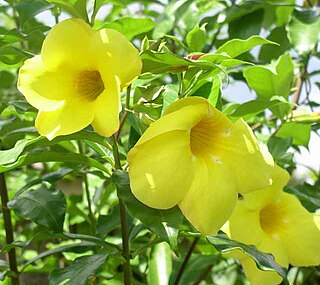
Allamanda cathartica, commonly called golden trumpet, common trumpetvine, and yellow allamanda, is a species of flowering plant of the genus Allamanda in the family Apocynaceae. It is native to Brazil. This plant is cited in Flora Brasiliensis by Carl Friedrich Philipp von Martius.

August Wilhelm Eichler, also known under his Latinized name, Augustus Guilielmus Eichler, was a German botanist who developed a new system of classification of plants to reflect the concept of evolution. His author abbreviation in botany is Eichler.

Gomphrena is a genus of plants in the family Amaranthaceae. They are known as the globe amaranths.
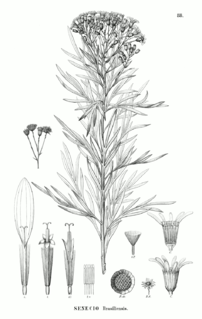
Flora Brasiliensis is a book published between 1840 and 1906 by the editors Carl Friedrich Philipp von Martius, August Wilhelm Eichler, Ignatz Urban and many others. It contains taxonomic treatments of 22,767 species, mostly Brazilian angiosperms.

Verbena brasiliensis, the Brazilian verbena or Brazilian vervain, is a flowering plant species from the vervain family (Verbenaceae). It is native to parts of South America, namely Brazil, but has spread its range in recent times and has occasionally become an invasive weed. It is an annual plant with purple flowers, and it has been introduced outside of its native range as an ornamental plant, and is now largely considered an invasive weed in these regions.
Ruellia verbasciformis is a plant native to the Cerrado vegetation of Brazil. This plant is cited in Flora Brasiliensis by Carl Friedrich Philipp von Martius.
Hygrophila costata, with the common names glush weed, gulf swampweed, and yerba de hicotea, is an aquatic plant
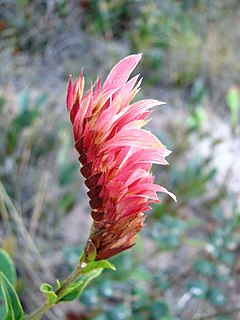
Lophostachys floribunda is a plant native to the Caatinga and Cerrado vegetation of Brazil. This plant is cited in Flora Brasiliensis by Carl Friedrich Philipp von Martius.
Justicia tocantina is a plant native to Argentine, and the Cerrado vegetation of Brazil. This plant is cited in Flora Brasiliensis by Carl Friedrich Philipp von Martius.
Stenandrium pohlii, with Portuguese common names caiapiá or carapiá, is a plant native to Cerrado and Pantanal vegetation of Brazil. The description of the plant was published in Flora Brasiliensis in 1847.
Stenandrium hirsutum is a plant native to the Cerrado vegetation of Brazil. The description of the plant was published in Flora Brasiliensis in 1847.
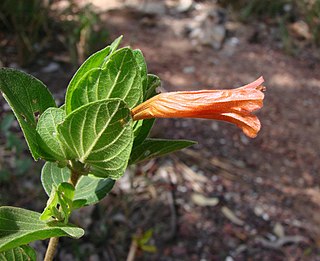
Ruellia villosa is a plant native to the Cerrado vegetation of Brazil. This plant is cited in Flora Brasiliensis by Carl Friedrich Philipp von Martius.
Aspidosperma dasycarpon is a tree native to Brazil, which is typical in Cerrado vegetation. This plant is cited in Flora Brasiliensis by Carl Friedrich Philipp von Martius. In addition, it is useful for beekeeping.

Aechmea gamosepala is a bromeliad endemic to southern Brazil. It is often cultivated as an ornamental plant. This plant is cited in Flora Brasiliensis by Carl Friedrich Philipp von Martius

Anemopaegma glaucum is a plant native to Caatinga and Cerrado vegetation in Brazil. This plant is cited in Flora Brasiliensis by Carl Friedrich Philipp von Martius.
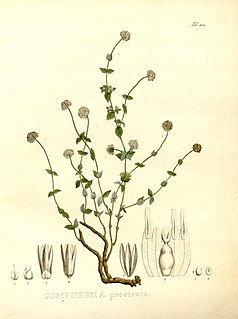
Gomphrena prostrata is a plant native to Caatinga and Cerrado vegetation in Brazil, specially in Bahia and São Paulo. This plant is cited in Flora Brasiliensis by Carl Friedrich Philipp von Martius.
Gomphrena pohlii is a plant native to Cerrado vegetation in Brazil, specially in São Paulo. This plant is cited in Flora Brasiliensis by Carl Friedrich Philipp von Martius.

An aurone is a heterocyclic chemical compound which is a type of flavonoid. There are two isomers of the molecule, with (E)- and (Z)-configurations. The molecule contains a benzofuran element associated with a benzylidene linked in position 2. In aurone, a chalcone-like group is closed into a 5-membered ring instead of the 6-membered ring more typical of flavonoids.
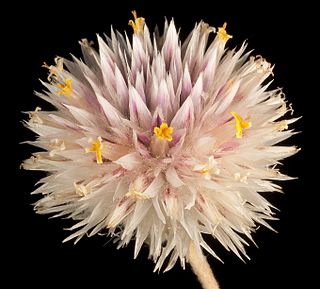
Gomphrena canescens is an erect herbaceous annual or perennial plant that is found in many parts of northern Australia. Growing from 0.1 to 0.9 m tall, it grows in a variety of sites, including soils based on clay, sand or skeletal soils. Seen in woodlands, rocky slopes, coastal dunes and disturbed areas. Attractive pink flowers form from February to September.












